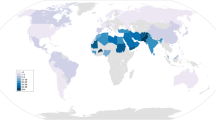Abstract
Psoriasis is an inflammatory skin disease that affects 2% of the population. It is characterised by red, scaly skin patches which are usually found on the scalp, elbows and knees, and may be associated with severe arthropathy. The lesions are caused by abnormal keratinocyte proliferation, and infiltration of inflammatory cells into the dermis and epidermis1. The usual age of onset of psoriasis is between 15 and 30 years, although it can present at any age. Psoriasis is recognised to have a large genetic component. Twin studies show the concordance in monozygotic twins to be between 65–70%2,3, compared to between 15–20%3 in dizygotic twins. Family studies estimate the risk to first degree relatives at between 8–23%4,5. However, there are also several environmental factors, including streptococcal infection6 and stress, that affect the onset and presentation of the disease. The mode of inheritance of psoriasis is unclear7. We conducted a genome-wide scan to search for psoriasis susceptibility loci in a single large multiplex family. Parametric linkage analysis indicated that a susceptibility locus for familial psoriasis was located on chromosome 4q. Investigation of this locus in five further multiplex families using both parametric and non-parametric methods gave significant localisation to chromosome 4q. The maximum total pairwise lod score obtained was 3.03 with the microsatellite marker D4S1535 at θ = 0.08. Non-parametric multipoint analysis with GENEHUNTER8 demonstrated significant excess allele sharing, with a P value of 0.0026, at the same locus.
Similar content being viewed by others
References
Fry, L. An Atlas of Psoriasis. (Parthenon Publishing, London, 1992).
Brandrup, F. et al. Psoriasis in monozygotic twin: variations in expression in individuals with identical genetic constitution. Acta. Dermat. 62, 229–236 (1982).
Farber, E.M., Nall, I. & Watson, W. Natural history of psoriasis in 61 twin pairs. Arch. Dermatol. 109, 207–211 (1974).
Hellgren, I., Psoriasis: The prevalence in sex, age and occupational groups in total populations in Sweden: morphology, inheritance and association with other skin and rheumatic diseases (Almqvist & Wiksell, Stockholm, 1967).
Lomholt, G., Psoriasis, Prevalence, Spontaneous Course and Genetics. (G.E.C Gad, Copenhagen, 1963).
Norlind, R. Significance of infections in the origin of psoriasis. Acta. Rheumatol. Scand. 1, 135–144 (1953).
Elder, T. et al. The genetics of psoriasis. Arch. Dermatol. 130, 216–224 (1994).
Kruglyak, L., Daly, M.J., Reeve-Daly, M.P. & Lander, E.S. Parametric and non-parametric linkage analysis: a unified multipoint approach. Am. J. Hum. Genet. 58, 1347–1363 (1996).
Tomfohrde, J. et al. Gene for familial psoriasis mapped to the distal end of human chromosome 17q. Science 264, 1141–1145 (1994).
Matthews, D., Fry, L., Powles, A., Weissenbach, J. & Williamson, R. Confirmation of genetic heterogeneity in familial psoriasis. J. Med. Genet. 32, 546–548 (1995).
Nair, R. et al. Scanning chromosome 17 for psoriasis susceptibility: Lack of evidence for a distal 17q locus. Hum. Hered. 45, 219–230 (1995).
Lander, E. & Kruglyak, L. Genetic dissection of complex traits for interpreting and reporting linkage results. Nature Genet. 11, 241–246 (1995).
Hobbs, H., Brown, M. & Goldstein, J. Molecular genetics of the LDL receptor gene in familial hypercholesterolemia. Hum. Mut. 1, 445–466 (1992).
Miller, S., Dykes, D. & Polesky, H. Extraction of high molecular weight DNA from human nucleated cells. Nucl. Acids Res. 16, 1215 (1988).
Weber, J. & May, P. Abundant class of human DNA polymorphisms which can be typed using the polymerase chain reaction. Am. J. Hum. Genet. 44, 388–396 (1989).
Dubovsky, J., Sheffield, V., Duyk, G. & Weber, J. Sets of short tandem repeats polymorphisms for efficient linkage screening of the human genome. Hum. Mol. Genet. 4, 449–452 (1995).
Gyapay, G. et al. The 1993-94 Genethon human genetic linkage map. Nature Genet. 7, 246–339 (1994).
Dib, C. et al. A comprehensive genetic map of the human genome based on 5264 microsatellites. Nature 380, 152–154 (1996).
Lathrop, G. & Lalouel, J. Easy calculations of lod scores and genetic risk on small computers. Am. J. Hum. Genet. 36, 460–465 (1984).
Hudson, T. et al. An STS-based map of the human genome. Science 270, 5244 (1995).
Author information
Authors and Affiliations
Rights and permissions
About this article
Cite this article
Matthews, D., Fry, L., Powles, A. et al. Evidence that a locus for familial psoriasis maps to chromosome 4q. Nat Genet 14, 231–233 (1996). https://doi.org/10.1038/ng1096-231
Received:
Accepted:
Issue Date:
DOI: https://doi.org/10.1038/ng1096-231
- Springer Nature America, Inc.
This article is cited by
-
Digestive system in psoriasis: an update
Archives of Dermatological Research (2017)
-
Genetic Epidemiology of Psoriasis
Current Dermatology Reports (2014)
-
The Genetics of Psoriasis and Psoriatic Arthritis
Clinical Reviews in Allergy & Immunology (2013)
-
Psoriasisarthritis
Zeitschrift für Rheumatologie (2011)
-
Molecular Dissection of Psoriasis: Integrating Genetics and Biology
Journal of Investigative Dermatology (2010)





